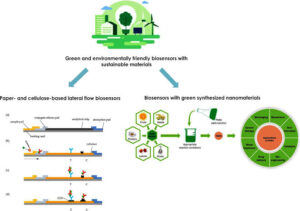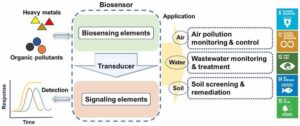Back to: MICROBIOLOGY 500 LEVEL
Welcome to class!
My ever-curious environmental hero, welcome again! I’m so proud of your passion for learning. Today’s topic—Biosensors for Environmental Monitoring—is one of the coolest ways science is helping us keep our air, water, and soil clean. Imagine tiny biological tools that act like environmental detectives, sniffing out pollution, even in places humans can’t see. That’s exactly what biosensors do!
Let’s find out how they’re helping Nigeria and the world stay safe and healthy.
Biosensors For Environmental Monitoring
What Are Biosensors?
A biosensor is a device that uses biological materials (like enzymes, antibodies, or microbes) combined with an electronic system to detect specific substances in the environment.

Simply put, it’s like a smart nose that can tell you if there’s something harmful in your surroundings—be it toxic gas, heavy metal in water, or pesticide in the soil.
Every biosensor has three main parts:
Biological element – this detects the target substance (e.g. bacteria that reacts to pollutants).
Transducer – this converts the biological reaction into a readable signal.
Display system – this shows the result (e.g. colour change or digital reading).
How Are They Used in Environmental Monitoring?
In Nigeria, environmental pollution from oil spills, factory waste, and pesticides is a big concern. Biosensors are now being used to monitor:
Water pollution – detecting heavy metals like lead and mercury in drinking water.
Air quality – checking for harmful gases like carbon monoxide or sulphur dioxide.
Soil contamination – sensing pesticide residues in farmlands.
Waste management – monitoring toxins in industrial effluents.
Examples of Biosensors
Microbial biosensors – Use bacteria like Pseudomonas to detect oil or heavy metals.
Enzyme-based sensors – Use enzymes that react with pesticides and change colour.
DNA biosensors – Detect specific DNA from pathogens or genetically modified organisms (GMOs) in soil or water.
Electrochemical biosensors – Measure changes in electrical current when a pollutant is detected.
Real-Life Scenario:
Let’s say a farmer in Benue wants to check if his borehole water has been polluted by nearby factory waste. A portable biosensor could give a quick, reliable reading—right there on the farm—without needing a big lab or expert technician.
Why Are Biosensors Important in Nigeria?
They’re affordable and easy to use, even in rural areas.

They provide fast and accurate results.
They help in early detection of pollution before it becomes dangerous.
They support efforts by NAFDAC, NESREA, and researchers to enforce environmental laws.
Summary
- Biosensors are devices that combine biological materials with electronics to detect pollutants.
- They are used in monitoring water, air, and soil pollution.
- Types include microbial, enzyme-based, DNA, and electrochemical biosensors.
- In Nigeria, they support fast, affordable, and localised pollution detection.
Evaluation
- What are the three main parts of a biosensor?
- Name two ways biosensors are used in environmental monitoring.
- Why are biosensors useful for rural areas in Nigeria?
Well done today, environmental champion! You’re not just learning—you’re preparing to become a guardian of Nigeria’s environment. With knowledge like this, you can develop solutions that protect our water, land, and future. Keep asking questions and growing. Afrilearn is always here, rooting for your greatness. See you next class!
